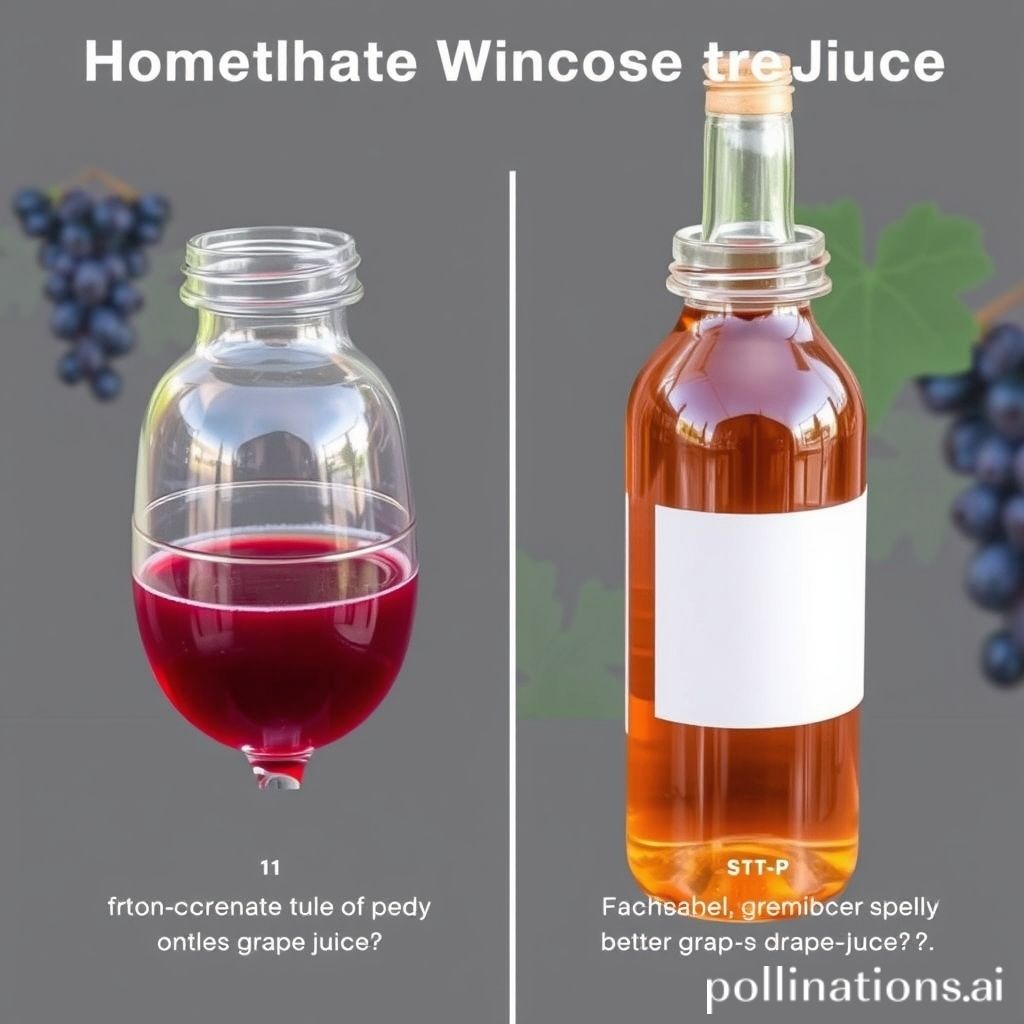How To Make Homemade Wine From Grape Juice?
Get ready to embark on a delicious journey with our simple and satisfying homemade wine recipes using grape juice. Whether you’re a wine connoisseur or a beginner, our easy-to-follow steps will have you sipping on your own homemade wine in no time.
From rich and bold reds to crisp and refreshing whites, we have a variety of grape juice options to suit your taste preferences. Impress your friends and family with your newfound winemaking skills, or simply indulge in a glass of your own creation after a long day. Join us as we explore the art of winemaking with grape juice, and discover the joy of crafting your own flavorful creations.

Table of Contents
Advantages of Creating Homemade Wine from Grape Juice
1. Health Benefits:
Creating homemade wine from grape juice provides numerous health advantages. Grapes contain antioxidants that combat free radicals and decrease the risk of chronic illnesses like heart disease and specific types of cancer. Furthermore, red wine made from grape juice contains resveratrol, a compound with potential anti-aging and anti-inflammatory properties.
2. Cost-Effective:
By creating your own wine from grape juice, you can save money compared to purchasing commercially produced wines. Grape juice is readily available at affordable prices, allowing you to experiment with different flavors and develop unique blends without spending excessively.
3. Control Over Ingredients:
When creating homemade wine, you have full control over the ingredients used. You can choose organic grape juice, ensuring the absence of pesticides or harmful chemicals in your wine. Additionally, you can adjust sugar levels and select specific yeast strains to personalize the taste and aroma according to your preferences.
4. Creative Expression:
Creating homemade wine from grape juice presents an opportunity for creative expression. You can explore various grape varieties, fermentation techniques, and aging processes to develop distinct flavors and styles. It allows you to unleash your creativity and produce wines that reflect your personal taste and preferences.
5. Bonding Experience:
Creating wine from grape juice can be a enjoyable and fulfilling activity to share with family and friends. It brings people together, encourages collaboration, and creates lasting memories. From harvesting grapes to bottling the final product, the entire winemaking process can be enjoyed as a group, strengthening relationships and fostering a sense of camaraderie.
Expert Tips: Create your own wine from grape juice for health benefits, cost savings, ingredient control, creative expression, and a bonding experience. #homemadewinePreparing the Grape Juice
- Sterilizing the fermentation vessel: To ensure a clean and sterile environment for the fermentation process, it is important to thoroughly sterilize the fermentation vessel. This can be done by using a sterilizing solution and following the manufacturer’s instructions.
- Adjusting the acidity level: The acidity level of the grape juice plays a crucial role in the fermentation process and the overall taste of the wine. It is recommended to measure the acidity using a pH meter or test strips and adjust it if necessary. This can be done by adding tartaric acid or citric acid to increase acidity or adding calcium carbonate to reduce acidity.
- Adding yeast to start fermentation: Yeast is responsible for converting the sugars present in the grape juice into alcohol. It is important to select the appropriate type of wine yeast for the desired flavor profile. The yeast can be added directly to the grape juice and mixed well to ensure even distribution.
| Step | Description |
|---|---|
| 1 | Sterilizing the fermentation vessel |
| 2 | Adjusting the acidity level |
| 3 | Adding yeast to start fermentation |
Choosing the Perfect Grape Juice
Touching on making homemade wine from grape juice, it is essential to select the right grape juice. The flavor and aroma of your homemade wine depend greatly on the quality and variety of grape juice you choose. To guarantee a successful and flavorful batch, follow these helpful tips for selecting the perfect grape juice:
1. Grape Variety:
Take into consideration the grape variety when choosing your grape juice. Different grape varieties have distinct flavors and characteristics that will influence the taste of your wine. Some common grape varieties used in winemaking include Merlot, Cabernet Sauvignon, Chardonnay, and Pinot Noir.
2. Juice Quality:
Ensure that the grape juice you select is of the highest quality. Look for juice made from freshly harvested grapes without any additives or preservatives. The freshness of the juice will greatly enhance the flavor and the success of the fermentation process.
3. Sugar Content:
Check the sugar content of the grape juice. The level of sugar will determine the alcohol content of your wine. Consider your desired alcohol level and choose a grape juice with an appropriate sugar content. If needed, you can adjust the sugar level during the winemaking process.
4. Organic or Conventional:
Decide whether you prefer organic or conventional grape juice. Organic grape juice is made from grapes grown without the use of synthetic pesticides or fertilizers, At the same time conventional grape juice may contain traces of these substances. Choose according to your personal preferences and values.
Conclusion:
By carefully selecting the right grape juice for your homemade wine, you can ensure a delicious and enjoyable end product. Consider the grape variety, juice quality, sugar content, and your preferences regarding organic or conventional options. With careful selection, you’ll be well on your way to crafting your own delightful homemade wine.

Preparing the Grape Juice
- 1. Choosing the Grape Juice
- 2. Straining the Grape Juice
- 3. Testing the Grape Juice
- 4. Adjusting the Grape Juice
| Information |
|---|
In this section, we will guide you through the process of preparing the grape juice for making homemade wine. Follow these steps carefully for the best results:
1. Choosing the Grape Juice: Select high-quality grape juice that is free from additives or preservatives. Look for varieties that are suitable for winemaking, such as Concord or Cabernet Sauvignon.
2. Straining the Grape Juice: Before moving forward, strain the grape juice to remove any impurities or solids. This will ensure a cleaner and smoother wine. Use a fine mesh strainer or cheesecloth for this step.
3. Testing the Grape Juice: It is important to test the grape juice to determine its sugar content. Use a hydrometer or refractometer to measure the specific gravity or Brix level. This will help you determine the potential alcohol content of the wine.
4. Adjusting the Grape Juice: Based on the sugar content test, you may need to make adjustments to the grape juice by adding sugar or water. This will help you achieve your desired alcohol level and balance the flavors. Follow a reliable recipe or consult a winemaking guide for guidance on making adjustments.
Fermentation Process
In the process of making homemade wine from grape juice, fermentation is a crucial step that turns the juice into delightful wine. Fermentation happens when yeast consumes the sugars in the grape juice, converting them into alcohol and carbon dioxide. This natural process gives each wine its unique flavors and aromas.
1. Yeast Selection
Choosing the right yeast for fermentation is important to achieve the desired flavors and aromas in the wine. Different types of yeast can produce different results, so it’s important to choose a yeast that complements the grape variety and desired wine style.
2. Adding Yeast
Once the grape juice is prepared, the selected yeast is added. The yeast consumes the sugars in the juice and converts them into alcohol. It’s important to make sure the yeast is properly hydrated and activated before adding it to the juice.
3. Fermentation Vessel
A suitable container, such as a glass carboy or food-grade plastic container, is used to hold the grape juice during fermentation. It should be properly cleaned to prevent any unwanted bacteria or contaminants from affecting the fermentation process.
4. Temperature Control
Temperature plays a crucial role in the fermentation process. It’s important to maintain a consistent temperature within the ideal range for the selected yeast strain. This ensures optimal fermentation and helps preserve the desired flavors and aromas.
5. Monitoring and Adjusting
During fermentation, it’s important to regularly check the progress by taking hydrometer readings. This helps determine the sugar levels and alcohol content. If needed, adjustments can be made by adding sugar or adjusting the acidity to achieve the desired taste.
6. Bottling and Storing the Wine
Once fermentation is complete, the wine is ready to be bottled. It’s important to use sterilized bottles and proper corks or closures to ensure the wine remains free from contamination. The bottled wine should then be stored in a cool, dark place to age and develop its flavors over time.
Conclusion
Making homemade wine from grape juice is a simple and enjoyable process that allows you to create your own delicious and unique flavors. By adhering to the steps in this article, you can transform grape juice into a delightful homemade wine.
Remember to choose high-quality grape juice, use the right yeast, and properly sanitize your equipment to ensure a successful fermentation. Experiment with different grape varieties and additives to create your own signature wines. With a little patience and practice, you can become a skilled winemaker and impress your friends and family with your homemade creations. Cheers to your winemaking journey!
FAQ about How To Make Homemade Wine From Grape Juice?
FAQ 1: Can I use any type of grape juice?
Yes, you can use any type of grape juice to make homemade wine. It is recommended to choose high-quality grape juice for the best results.
FAQ 2: How long does the fermentation process take?
The fermentation process for homemade wine typically takes around 1-2 weeks. Although, the duration may vary depending on various factors such as temperature and yeast activity.
FAQ 3: What is the ideal temperature for fermentation?
The ideal temperature for fermentation is between 70-75 degrees Fahrenheit (21-24 degrees Celsius). This temperature range promotes optimal yeast activity and helps in achieving the desired flavor and alcohol content.
FAQ 4: How long should I let the wine age?
It is recommended to let the homemade wine age for at least 3-6 months. Aging allows the flavors to develop and mellow out, resulting in a smoother and more enjoyable taste.
FAQ 5: Can I use homemade wine for cooking?
Yes, you can use homemade wine for cooking. It can add depth and richness to various dishes, including sauces, marinades, and desserts. Just ensure that the wine you use for cooking complements the flavors of the dish you are preparing.
Read Similar Post:
1. Deliciously Fresh Muscadine Grape Juice Recipe – Easy DIY Guide!
2. Grape Juice: The Natural Headache Remedy You Need!

